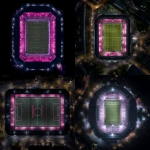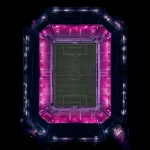Explore the Best AI Image Gallery

Beyond Reality: How VR and AR are Transforming Gaming and Creativity
The realms of gaming and creativity are undergoing a seismic shift thanks to the advent of virtual reality (VR) and augmented reality (AR). These immersive technologies are not just changing how we play games, but also revolutionizing artistic expression, design, and storytelling. From interactive narratives that blur the lines between fiction and reality to collaborative creative spaces that transcend physical boundaries, VR and AR are paving the way for a future where imagination knows no limits.
Gaming: A New Dimension of Immersion
VR gaming has catapulted players into entirely new worlds, offering unprecedented levels of immersion. By donning a headset, gamers can step inside their favorite games, interact with virtual environments, and experience narratives in a way that was previously unimaginable. This level of presence fosters a deeper emotional connection to the game world and its characters.
- Enhanced Immersion: VR removes the barrier between player and game, creating a sense of presence that transports players into the heart of the action.
- Intuitive Interaction: Controllers and motion tracking allow for natural and intuitive interactions within virtual worlds, making gameplay more engaging and responsive.
- Novel Gameplay Mechanics: VR opens up new possibilities for gameplay mechanics, enabling experiences that would be impossible in traditional games.
AR: Enhancing Reality with Digital Overlays
Augmented reality overlays digital elements onto the real world, creating interactive and informative experiences. While not as immersive as VR, AR has a unique ability to blend the physical and digital realms, enhancing our perception of reality.
- Interactive Storytelling: AR can bring stories to life by layering digital characters, objects, and narratives onto real-world locations.
- Educational Applications: AR can provide interactive learning experiences, allowing users to explore 3D models of historical artifacts or visualize complex scientific concepts.
- Marketing and Advertising: AR can create engaging and interactive marketing campaigns that capture attention and enhance brand experiences.
The Impact on Creative Industries
VR and AR are reshaping the creative landscape, empowering artists, designers, and developers to explore new frontiers:
- Immersive Art Experiences: VR allows artists to create installations that envelop viewers in entirely new worlds, fostering a deeper emotional connection with their work.
- Interactive Design: AR enables designers to prototype and showcase products in real-world environments, allowing for more intuitive and collaborative design processes.
- Collaborative Creative Spaces: VR can connect artists, designers, and developers from around the world, fostering collaboration and innovation on a global scale.
Ethical Considerations
As with any powerful technology, VR and AR raise important ethical considerations:
- Privacy Concerns: The use of sensors and cameras in VR and AR devices raises concerns about data privacy and the potential for misuse.
- Digital Divide: Access to VR and AR technologies may be uneven, exacerbating existing inequalities and creating new divides.
- Mental Health Impacts: Prolonged exposure to immersive virtual environments could have psychological impacts, requiring careful consideration and safeguards.
Future Trends
The future of VR and AR in gaming and creativity is bright. We can expect to see:
- More Realistic and Immersive Experiences: Advances in hardware and software will continue to push the boundaries of realism, creating even more convincing and engaging virtual worlds.
- Integration with Other Technologies: VR and AR will increasingly integrate with other technologies such as artificial intelligence (AI) and blockchain, opening up new possibilities for interactive experiences and creative expression.
- Wider Accessibility: As prices decrease and technology becomes more accessible, VR and AR will become mainstream tools for entertainment, education, and creative endeavors.
VR and AR are not just technological advancements; they are catalysts for human connection, imagination, and innovation. By embracing these transformative technologies, we can unlock new realms of creativity and redefine the way we interact with the world around us.

](https://images.ai-img.art/thumbnails/150/83ec831b9fb19e0db5a520b051b9556f3f594b87acc957ffee094a06a565e6f0.webp)



](https://images.ai-img.art/thumbnails/150/69d81ae5ecde297f3c11da78435c5fc00fbac7b00e2c7ccd89d7bbeb014e0541.webp)
](https://images.ai-img.art/thumbnails/150/fc468fe14407b96489933a55227127071fd5f6c0505be74ca4dcb2f1e2fa3771.webp)




](https://images.ai-img.art/thumbnails/150/908bcb9950a44fd4b37d1a84cf00178988cea9507738d7ad4f92707c692461ef.webp)




](https://images.ai-img.art/thumbnails/150/05b3252b3f681226a3df9027b069db31c005f91b72257a74367c4102f03a2ba0.webp)



](https://images.ai-img.art/thumbnails/150/3ccc82ef0ad0cc1ab1dfb5b8e6bc37924fcad45dadf41cbd1cb21d19fc7f640a.webp)







](https://images.ai-img.art/thumbnails/150/807ac97f95d56e8cc7cf714e13299d80bf6bcb5b4d80b77a7f06f30246184943.webp)






](https://images.ai-img.art/thumbnails/150/738b292720ee21b57673dfb75ad851f4c34d16f5006ae3027ba685feaddb6b04.webp)









](https://images.ai-img.art/thumbnails/150/57afc09cc38edf73880f760b7ebe1852c5522c6b4051836717b2e56b6f7f913c.webp)
